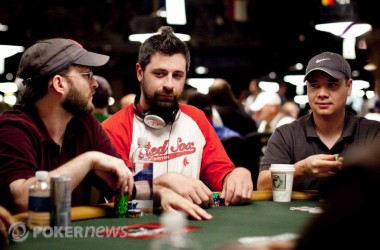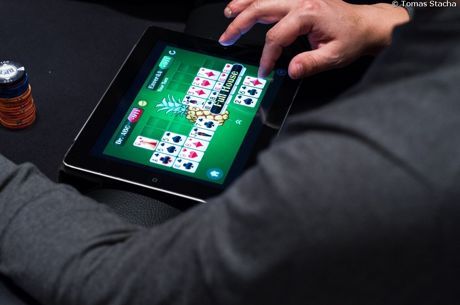Bankroll Builders, Vol. 11: 27 and 45-man SNGs, Part 2

In the last edition of Bankroll Builders, we introduced you to 27- and 45-man sit-n-goes, showed you where to find them, and laid out a plan for bankroll management. Now it��s time to get down to the nitty-gritty and discuss a basic strategy for success. Although blind and payout structures vary slightly from site to site, for simplicity��s sake we��ve used PokerStars�� standard and turbo structures for our purposes in describing each stage of a multitable SNG. The strategies outlined can be used, however, for any 27- or 45-man tournament.
Early-stage play: Build a stack
A 45-man turbo SNG on PokerStars takes about 75 minutes to play from start to finish, and a standard-speed one of these takes about twice as long. Simply by looking at the blind structure, you��ll be able to quickly figure out how many chips you��ll need to accumulate to have an average stack at the final table. In 45-player turbo on Stars, it will take ten or eleven five-minute levels to reach the final table, putting the blinds at 400/800 with a 50 ante or 600/1,200 with a 75 ante. The average stack size at that point will be 7,500 chips �� that��s between six and nine big blinds! Building a stack early will give you a tremendous advantage going into the middle stages of play when many of your opponents will be so short-stacked they have no options but to shove or fold.
In the early stages of play, look for inexpensive spots to see flops and potentially double up. Play your big pairs and big aces aggressively (especially in a turbo because you don��t have the luxury of time), but also look for spots where you can limp in to a multiway pot with small and medium pairs, and suited connectors. Don��t mess around with junky hands like ace-rag or unsuited gappers, even from late position. The blinds you��re trying to steal with a hand like that aren��t high enough to warrant the risk. The same thing goes for all that light three-betting and four-betting you might witness in a larger MTT. Most of the players in low-limit multi-table SNGs are, on the whole, not smart enough to fold a decent hand in many of the spots where you��re trying to make them do just that. So why risk it? Focus on accumulating as many chips as you can before the blinds reach 75/150. At that point, an unimproved starting stack will be worth only ten big blinds.
Middle-stage play: Steal, steal, and re-steal
Twenty minutes into a turbo 45 (or about 40-45 minutes in a standard-speed 45), the blinds will be 75/150 and there will be around 30 players remaining. From here on out, the average stack is going to be anywhere from eight to 12 big blinds. Because there is hardly any room for postflop play beyond this stage, the best way to grow your stack is to find good spots to steal blinds or resteal from late position raisers. If you��re running a program like PokerTracker or Hold��em Manager, your heads-up display should have a small but still reasonable sample size on at least some of your opponents, which will give you a decent idea about how tightly or loosely they��ve been playing so far.
Although 27-player SNGs pay the top five spots and 45-player tourney pay six or seven, the real money is in the top three spots. Playing to min-cash these tournaments results is slow, steady bankroll death. Sure, you might bust out on a coinflip you could have potentially avoided, or bubble off the money shoving king-rag into pocket queens, but if you nit it up too much and don��t push your edges, a first-place finish will remain just out of reach.
Lucky for you, there will be plenty of people folding too much and trying to squeak into the money. Punish them! Identify the short- and medium-sized stacks that are playing too scared and steal their blinds with abandon.
So where are some good spots to steal? If players with an average stack or below are still limping in by the middle levels, put them to a decision and shove from position. Another spot that is ripe for stealing is when a player limps in on the button rather than raising. Sure, it could be a trap but the vast majority of the time, it isn��t. If you��re in the blinds and are facing a button limp, a shove might be your most profitable play. If the action has folded around to you in the small blind and there��s a player with a stack between four and eight big blinds behind you, more often than not it��s a good spot to shove and steal the blinds.
Late-stage play: Go for the win
By the time you reach the money in a turbo 45, nearly everyone at the table will have less than ten big blinds. If you have a big stack at this point, your first instinct might be to tighten up and try to climb up as many rungs on the pay ladder as you can. The better move, however, is to maintain the aggressive image you��ve built up. If you keep putting pressure on your opponents and wielding that stack like a weapon, people will be less likely to play back at you.
Late-stage play in a 45-man SNG is about playing as close to perfect push-or-fold poker as you can. Brush up on your ICM and download a tool like PokerStove to help you determine a profitable shoving range in different situations. Running the math on some of your late-tournament hands after play wraps will help immensely and open your eyes to some other spots where you could have shoved profitably.
Ready to start building your own bankroll? Open an account at one of our online poker rooms and get on the grind.








